In this article
This guide addresses the core question of what shoes to wear when hiking, and it’s designed to be more than a simple list of “best shoes.” It’s a comprehensive decision-making framework to empower you, the hiker, to move from confusion to confidence. We will demystify the complex world of hiking footwear, helping you move beyond “best of” lists to learn why hiking shoes are built the way they are. We will introduce a simple yet powerful framework based on four pillars—you, your adventure, the gear, and the fit—so you can make an informed decision for any future hike. You’ll understand how the right footwear is your first line of defense against common pains like blisters and foot fatigue, refining your gear selection skills whether this is your first pair or your tenth.
The Starting Line: Comparing the Four Main Types of Hiking Footwear
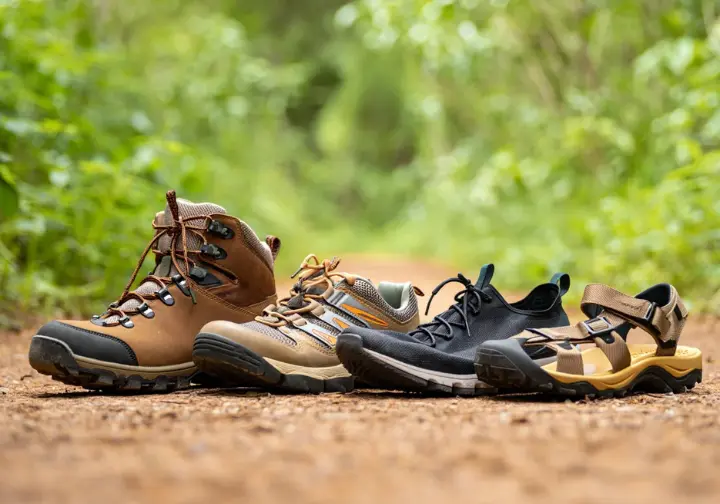
Before diving into technical details, it’s foundational to understand the main categories of hiking footwear. Your first major decision in figuring out what shoes should i wear for hiking will be choosing which of these four types best aligns with your primary hiking style and philosophy. Each offers a different balance of support, weight, and protection for the trail ahead.
Hiking & Backpacking Boots: Maximum Support and Durability
Defined by their mid or high-cut design, traditional hiking and backpacking boots are engineered for maximum stability and ankle protection. These hiking boots are the classic choice for navigating rugged, off-trail terrain in the wilderness. They are indispensable when carrying heavy backpacks (typically over 25-30 lbs) that place significant stress on your feet and joints. Their stiff construction, often featuring an internal shank, helps prevent foot fatigue over long distances with heavy loads, providing the crucial ankle support for stability. The category also includes even stiffer mountaineering boots for the most technical trekking and mountaineering.
The primary trade-offs for this level of protection are weight and a longer break-in period. A new leather shoe of this type requires time to soften and conform to your foot’s unique shape. This investment is rewarded with durability, often lasting for thousands of miles. According to the National Park Service’s official safety recommendations for hikers, proper footwear is key, just like carrying essential backpacking safety gear. These boots excel in cold, wet, or muddy conditions.
Hiking Shoes: The Versatile All-Rounder
Hiking shoes are low-cut versions of their taller boot counterparts, offering a compelling balance of features. A modern hiking shoe retains much of the stiffness, support, and durability of a boot but in a lighter, more agile package. This makes them an exceptionally versatile choice for a wide range of activities, from local hiking trails to more demanding day hikes. This do-it-all hiking shoe represents a smart middle ground for many outdoor adventurers.
These are often the ideal choice for day hikers and those on light backpacking trips with packs under 25 lbs. They provide significantly more protection and underfoot support than a trail runner, making them suitable for rocky trails. While they lack the high-cut ankle protection of a full high-cuff hiking boot, they offer more freedom of movement and are generally comfortable out of the box. Adhering to good trail safety considerations is always wise, and these shoes provide a solid foundation.
Trail-Running Shoes: Lightweight, Agile, and Comfortable
Trail-running shoes have become the dominant choice for thru-hikers and fast-and-light enthusiasts in the modern hiking world. These lightweight shoes prioritize low weight, flexibility, and out-of-the-box comfort above all else. The core philosophy is that saving energy with every step is paramount for long-trail efficiency and reducing overall fatigue during thru-hiking.
This lightweight advantage comes with a trade-off in durability. Trail runners are typically the least durable shoe category, often needing replacement every 300-500 miles. They offer minimal support for carrying heavy loads, as their soft midsoles and flexible construction are not designed for the stress of a heavy backpack. They are best suited for hikers on well-maintained trails, those carrying ultralight packs, or anyone who values speed. Their breathable mesh uppers also mean they get wet easily but dry very quickly.
Hiking Sandals: Unmatched Breathability for Hot Weather
Hiking sandals are a specialized category designed for maximum ventilation and water management. Characterized by secure strap systems and aggressive, trail-ready outsoles, these sandals are far more capable than casual flip-flops. Their primary advantage is breathability, making them ideal for summer hiking or on trails with stream crossings. This is especially true when preparing for a desert day hike, where heat management for your feet is critical.
When hiking sandals get wet, they dry almost instantly, which can be a major benefit. They are a popular choice for warm-weather hiking and as a comfortable camp shoe. However, they offer the least amount of protection from trail hazards like sharp rocks or roots. For those considering any type of special hiking footwear, it’s wise to seek expert-informed guidance on foot health to make the best choice.
The Hiker’s Decision Framework: Assessing Yourself and Your Adventure

The “best” shoe doesn’t exist in a vacuum; it’s relative to you and the hikes you plan to do. Before looking at any specific product, you must first analyze your personal needs and the demands of your intended adventures. This self-assessment is the most important part of the selection process.
Pillar 1: The Hiker’s Profile (The “You”)
Your personal characteristics are the first critical piece of the puzzle. Consider your hiking experience level; beginners often benefit from more supportive and forgiving footwear as they build trail confidence. Experienced hikers may prioritize a lightweight hiking shoe, having developed the necessary strength. Your unique foot anatomy is paramount. Do you have high arches or flat feet? Do you have wide feet that necessitate a roomier toe box to prevent your toes from pinching?
Your physical history is another key factor. If you have a known propensity for twisting your ankles, a mid or high-cut boot might provide the confidence you need. If you are prone to conditions like plantar fasciitis, focusing on a supportive hiking shoe is a must. Taking these steps is the first line of defense in preventing common hiking injuries.
Pillar 2: The Hike’s Profile (The “Adventure”)
The external variables of your hike are just as important as your personal profile. The single most significant factor is the weight of your backpack. A light daypack under 20 lbs places minimal stress on your feet, making a nimble hiking shoe a viable option. A multi-day pack over 25-30 lbs, however, increases plantar pressure and necessitates the added stiffness of beefier hiking shoes or boots. Research confirms the serious biomechanical effects of backpack weight on feet.
Analyze the terrain you’ll be frequenting, whether it’s the trails in Glacier National Park or your local park. Well-maintained trails are forgiving. Rugged and uneven trails demand more underfoot protection. Finally, consider the climate. Hot conditions make breathability the top priority, while a waterproof hiking boot is logical for cold, wet trails. The effect of backpack load on foot motions further underscores why this assessment for an extended hike is so important.
Deconstructing the Shoe: Understanding Anatomy and Key Technologies
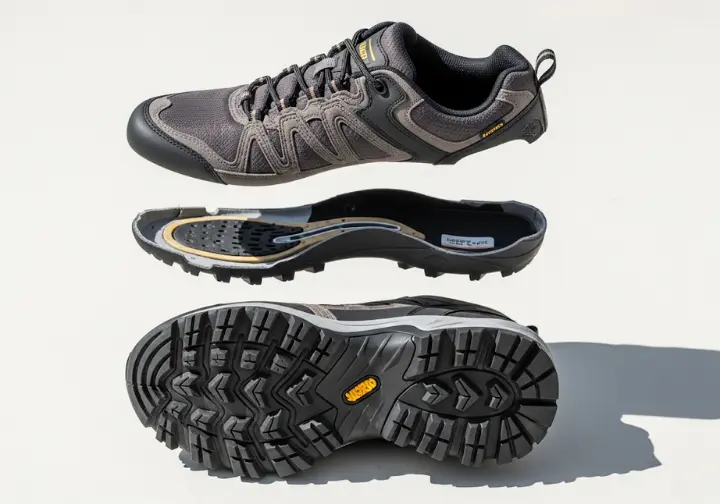
Once you’ve profiled yourself and your hike, you can analyze the gear itself. Understanding what is special about hiking shoes and their components will allow you to match specific features to the needs you’ve already identified. This knowledge turns you into an informed buyer.
Upper Materials: The Balance of Durability and Breathability
The upper is the main body of the shoe, and its material dictates the balance between durability, weight, and breathability. Full-grain or nubuck leather makes for very durable shoes, but they are also heavy and require a break-in period. On the opposite end are synthetic hiking shoes made of materials like polyester and mesh. They are lightweight, highly breathable, and dry quickly, but offer less durability than leather hiking shoes.
A very common middle ground is a hybrid construction that pairs split-grain leather with synthetic mesh panels. This design offers a good compromise, providing targeted durability in high-wear areas while maintaining better breathability and lower weight than an all-leather hiking shoe.
Midsoles & Support: The Engine of Your Shoe
The midsole is the layer that provides cushioning and determines the shoe’s overall stiffness. The two primary materials are EVA and Polyurethane (PU). EVA is a lightweight foam common in light hikers, but it breaks down more quickly. PU is a denser, firmer, and more durable material, which is why it’s the standard for high-end backpacking boots. A stable shoe with a good midsole can greatly boost walkability.
Within the midsole, you’ll find key support structures. Shanks add load-bearing rigidity, preventing the boot from flexing under a heavy pack. This rigidity is important, as studies show the influence of shaft stiffness on joint kinematics. Rock plates are thinner inserts, common in trail runners, that protect your foot from sharp rocks. The overall construction has measurable effects of shoe type on biomechanics.
Outsoles: Your Connection to the Trail
The outsole is the rubber layer that makes contact with the ground, providing all-important traction. High-performance outsoles from a reputable footwear brand like Vibram or Continental are a sign of quality. Different rubber compounds are used; stickier rubber offers better grip on rock but wears faster. Understanding these differences is part of the deep-dive into the biomechanics of running comparisons.
The pattern and depth of the lugs—the tread—are designed for specific conditions. Deep, widely spaced lugs excel at digging into soft terrain like mud. Shallower lugs provide more surface area contact for better grip on smooth, dry rock. A critical safety feature is the heel brake. This is a distinctly angled section of the outsole at the heel that helps prevent slipping during steep descents.
The Waterproofing Dilemma: Gore-Tex vs. Breathability
Waterproof/breathable membranes, most famously Gore-Tex (GTX), are a common feature in many waterproof hiking shoes but represent a critical trade-off. The membrane is designed to block external water while allowing sweat to escape. This technology is effective at keeping your feet dry from the outside.
No membrane, however, is perfectly breathable. In warm conditions, you will generate sweat faster than the membrane can vent it. This trapped moisture can lead to blisters. A shoe—once moisture gets inside from sweat—can take a long time to dry. The choice is strategic. For cold conditions, a waterproof shoe is often best. For hot climates, highly breathable shoes are superior, as nonwaterproof shoes will dry out much more quickly.
The Perfect Fit: The Single Most Important Step
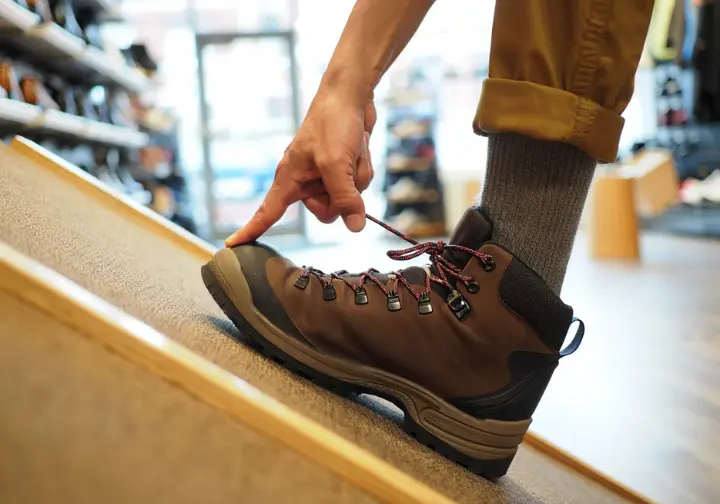
All the technology in the world is useless if the shoe doesn’t fit correctly. A proper fit is the final and most critical pillar of your decision, directly impacting your comfort and preventing injury on the trail. Do not rush this step with your new footwear.
Getting the Right Size
The first rule of sizing is to ignore your street shoe size. Hiking footwear should almost always be a half to a full size larger. This accommodates natural swelling and helps prevent your toes from slamming into the front of the shoe on descents, a painful condition that can affect your big toe. A loose shoe is also bad, but too tight is worse.
The gold standard is the “thumb’s width” rule. You should have a thumb’s width of space between your longest toe and the end of the shoe. It’s best to measure this using the shoe’s removable insole. Always try on new shoes at the end of the day when your feet are largest, and wear the exact type of thick socks you plan to hike in. This is a core part of any essential guide to hiking boots.
The In-Store (or At-Home) Try-On Process
Once you have the shoes on, a proper try-on involves more than just walking around. Find a small incline to simulate trail conditions. Walk up the incline to check for heel lift; your heel should feel locked in. As one podiatrist discusses how to choose hiking boots, this test is non-negotiable and something any good footwear specialist would recommend.
Next, walk down the incline. Your toes should not jam into the front. This is the most critical test to prevent bruised toes. Pay close attention to the width. The shoe should feel snug, but your toes should have ample room to wiggle and splay out naturally. There should be no pinching or hot spots.
The Break-In Period Explained
The “break-in period” primarily applies to stiff, full-grain leather hiking shoes. These materials need time to mold to your foot’s contours. You should never take a brand-new pair of heavy leather boots on a long hike. Start by wearing them around the house, then on short walks.
This gradual process allows the leather shoe to adapt to your foot. For most modern-day hiking shoes made of synthetics, a long break-in is not necessary. Their materials are softer out of the box. Still, it is wise to wear any new footwear on a few short hikes to ensure the fit is perfect before a long-distance trek.
Beyond the Shoe: The Complete Footwear System for Happy Feet

Your shoes are the foundation, but they don’t work in isolation. Socks and insoles are integral components of a complete system designed to maximize comfort and ensure an enjoyable hiking experience.
The Critical Role of Hiking Socks
The single most important rule of hiking socks is to avoid cotton. Cotton absorbs moisture and is a primary cause of blisters. Always choose appropriate socks made from merino wool or high-quality synthetics. Merino wool is the gold standard; it is exceptionally good at wicking moisture, it insulates even when damp, and it is naturally odor-resistant.
Sock cushioning and height should be matched to your footwear. More cushioning provides extra comfort but will be warmer. The sock height, whether low-cut or high socks, should be tall enough to prevent your boot from rubbing directly against your skin. Don’t just use your familiar athletic shoes socks; invest in a dedicated pair.
The Power of Aftermarket Insoles
The insoles that come with most hiking footwear are typically flimsy. For many sore-footed hikers, upgrading to an aftermarket insole can be a game-changer. These are designed to provide superior arch support, which can be crucial for preventing conditions like plantar fasciitis.
Beyond support, high-quality insoles from brands like Superfeet or SOLE offer better shock absorption. They also help to stabilize the foot within the shoe, reducing excess movement that can lead to blisters. Considering a better insole can be just as important as the other Ten Essentials for hiking when it comes to personal comfort.
Common Hiking Footwear Myths: Debunked
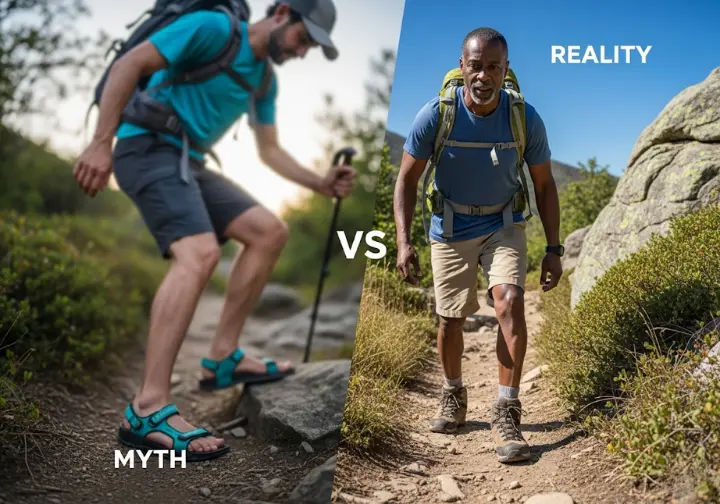
The hiking community is full of persistent myths. Let’s separate fact from fiction with evidence from footwear experts to ensure you’re making decisions based on sound principles.
Myth 1: You MUST Wear High-Top Boots for Ankle Support
This is one of the most enduring myths. While the high collar of a hiking boot—is protective, it does not function as a rigid brace to prevent serious ankle sprains. The single most important factor is developing strong ankles. Using trekking poles is also a highly effective way to improve stability and reduce the load on your joints.
For individuals who truly need mechanical support, a dedicated ankle brace provides far more effective stabilization than the boot’s collar alone. The primary benefit of a high-cuff hiking boot is protection from trail debris and structural support for heavy loads, not sprain prevention for skilled hikers.
Myth 2: Waterproof is Always the Superior Choice
The “Waterproof is Better” fallacy is a dangerous oversimplification. As discussed, the trade-off for waterproof footwear is a reduction in breathability. Trapped sweat from your feet is a leading cause of blisters. The superior choice is entirely dependent on the conditions. In hot, dry climates, a waterproof shoe can lead to overheated feet.
Expert thru-hikers often embrace a “strategic wet foot” approach. They choose non-waterproof hiking shoes that get wet easily but also dry extremely quickly. They understand that it’s often better to have a shoe that’s wet for an hour than one that’s damp with sweat all day long. This strategy prioritizes keeping dry feet from the inside out.
Key Takeaways for Your Next Footwear Purchase
Choosing the right hiking footwear is a skill. By applying this framework, you can confidently select the perfect pair, ensuring countless miles of comfortable adventure.
- There is No “Best” Shoe, Only What’s Best for You: The ideal choice is always a compromise based on your personal profile, your adventure’s demands, and the specific features of the gear.
- Master the Four Pillars: Always start by analyzing The Hiker (you), The Hike (your adventure), The Gear (its components), and The Fit (the crucial final step).
- Fit is Paramount: An expensive shoe that fits poorly is worse than a budget-friendly shoe that fits perfectly. Never compromise on fit.
- Think in Systems: Your footwear is more than just a shoe. Combine it with quality non-cotton socks and potentially aftermarket insoles to create a complete system for foot health.
- Trust Your Feet: Expert advice is just a guide. You are the final authority on what feels right for your feet during the entire hike.
Frequently Asked Questions about What Shoes to Wear When Hiking
How much should I expect to spend on a good pair of hiking shoes? +
How do I know when it’s time to replace my hiking shoes? +
Can I just use my regular gym/running shoes for hiking? +
What is the single most common mistake beginners make when buying hiking footwear? +
We are a participant in the Amazon Services LLC Associates Program, an affiliate advertising program designed to provide a means for sites to earn advertising fees by advertising and linking to Amazon.com. As an Amazon Associate I earn from qualifying purchases. We also participate in other affiliate programs. The information provided on this website is provided for entertainment purposes only. We make no representations or warranties of any kind, expressed or implied, about the completeness, accuracy, adequacy, legality, usefulness, reliability, suitability, or availability of the information, or about anything else. Any reliance you place on the information is therefore strictly at your own risk. Additional terms are found in the terms of service.




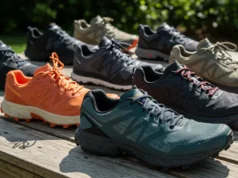
![Best Thru Hiking Shoes to Conquer Any Peak […] Hikers wearing trail runners and hiking boots on a mountain peak, showcasing the best thru-hiking shoes.](https://thehikingtribe.com/wp-content/uploads/2025/03/01-best-thru-hiking-shoes-peak-238x178.webp)





